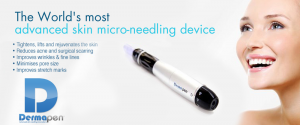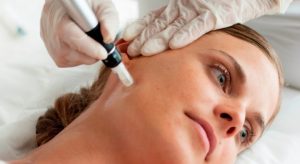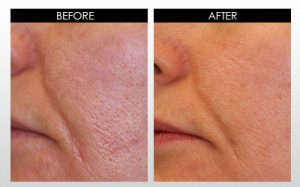Treatment of the week- Micro Skin-needling with Dermapen
What is micro-needling?
Micro-needling, also known as collagen induction therapy involves the creation of invisible micro-point punctures in your skin, the majority of which are just temporarily driving your pores open. Whilst this does not sound appealing, the procedure is virtually painless and unbelievably effective as your body perceives the micro injuries as damage to your skin, which in turn stimulates the cycle of the creation and release of the growth factors that initiate the production of both elastin and collagen.
A Dermapen treatment is an advanced non-surgical cosmetic procedure used to reduce wrinkles, , large pores, heal acne, surgical and burn scars as well as rejuvenate and tighten the skin.
A dermapen is a medically engineered and developed skin needling device that utilise 12 surgical grade micro-needles that deliver effortless and effective skin needling. Dermapen’s unique operation means that dramatic, long lasting results are attainable whilst facilitating the fastest procedural downtime for patients.
Dermapen has won numerous awards including the Best Skin rejuvenation device at the 2012 Las Vegas Aesthetic show and has become the most used device for vertical needling procedures by surgeons, dermatologists, doctors, nurses and skin therapists.
Uses of Micro needling with Dermapen
1)Fine line and deep wrinkle reduction.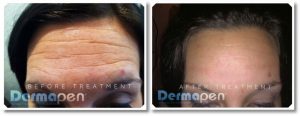
The ability of micro-needling to stimulate the growth of collagen and elastin which have long been established as the key elements of new, youthful looking skin has led to this procedure being internationally acclaimed as the most powerful treatment for stopping aging in its tracks and preventing new fine lines and wrinkles from forming.
With just a few sessions, due to its ability to trigger the generation of new skin cells, micro-needling will noticeably reduce fine lines, crow’s feet and, deep wrinkles on the forehead.
2)The repair of visible Acne and Trauma scars
During the micro-needling procedure, your skin is tricked into repairing itself beyond the formation of scar tissue, whereas in normal circumstances, your skin would usually assume that scars, stretch marks and wrinkles are already fully repaired. The results are a visible reduction in the redness of the marks and the diminishing of their appearance.
3)Reversal of sun damage of pigmentation. 
Studies have shown that repeated unprotected ultraviolet exposure, even for short periods at a time, breaks down collagen. In addition, as we age, collagen production in the skin decreases and the combined effect of sun and age has a detrimental effect on our skin. Through the stimulation of collagen growth with micro-needling you can not only reverse sun damage, but discoloration including the hyper pigmentation that comes with melasma too as micro-needling with Dermapen allows for the re-balancing and regulation of melanin production creating a more even and uniform skin tone.
Microneedling does not actually enlarge your pores, despite this being quite counter-intuitive. The increased production of collagen i and around your pores as a result of the treatment causes them to plum and appear shrunken, if not closed.
5) Increased Product absorption.
Not many people know that only four to eight percent of the serums (or any other skincare that you use) actually penetrates your skin. Many studies have confirmed that this treatment improves the ability of topical medications to penetrate your skin more efficiently which allows you to fully reap the full benefits of any product you chose to use. This is because the invisible holes that are created in your skin during the procedure are ready to absorb products in a way which clogged pores cant.
Benefits of micro-needling with a Dermapen
- Allergic reactions and side effects are unlikely to ensue, as the skin-needling process does not require the use of injections.
- The procedure is minimally invasive.
- The procedure requires a minimum amount of down time. Most patients can resume normal activity immediately after their treatment. Your skin post-procedure may be red and flushed, similar to the aesthetic appearance of a moderate sunburn. Skin tightness and mild sensitivity to touch may also be experienced on the areas that were targeted for the procedure. However, these symptoms are temporary and will diminish greatly after a few hours post-treatment, and within the next 24 hours, your skin will be restored to its initial state and completely healed. After 3 days, there will be little or no evidence that you have even undergone treatment.
- All skin types and colours can receive micro-needling safely. As the melanin producing cells remain intact with this procedure, as does your epidermis, during skin-needling, there is zero risk of post-inflammatory hyperpigmentation.
Why chose micro skin-needling with a Dermapen over other treatments?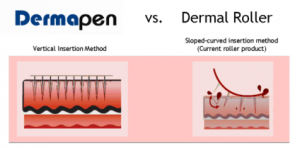
1) The Dermapen has very low risks associated with treatment compared to the dermal roller.
Prior to the invention of the Dermapen the most commonly used device for collagen induction therapy was the dermal roller. The Dermapen uses the same principle but rather than a rolling action, it moves needles in and out of the skin at a rate of roughly 1000 times per second. This means the issue of the rolling injury to the skin caused by use of a dermaroller that can occur is avoided.
2) The Dermapen is less painful than dermal rollers.
Dermapen carried out a study of 60 patients who suffered with acne scarring who had previously used dermal roller treatment. After Dermapen treatment, the patients unanimously felt that the procedure was much less painful than the dermal roller.
3)The Dermapen requires less downtime than dermal rollers.
The patients from the aforementioned study also unanimously agreed that post treatment downtime was much shorter. This means that you can get to your busy life shortly!
4)Dermapen produces better results than dermal rollers.
Participants in the study treated by the Dermapen felt that their atrophic acne scarring had improved to a greater extent than when treated by a dermal roller.
5) Dermapen can be used on anyone regardless of skin colour or type.
Certain invasive operations (such as laser resurfacing) are not recommended for those with Asian or African American skin due to the potential risks of pigmentary changes, delayed wound healing, and scarring. Therefore, skin-needling has the greatest advantage over other skin treatments; these potential dangers are highly unlikely due to the epidermis remaining intact both during and post-procedure.
Treatment origins of the Dermapen
- The use of needles for therapeutic benefit can be traced back as far as the Shang Dynasty (1600-1100BCE) with the traditional Chinese Medical practice of acupuncture. The insertion of acupuncture needles
 to specific body points rebalances the flow of energy in that area. In the same way cosmetic acupuncture stimulates the flow of blood and muscle activity rebalancing the area that is being treated.
to specific body points rebalances the flow of energy in that area. In the same way cosmetic acupuncture stimulates the flow of blood and muscle activity rebalancing the area that is being treated. - In 1995, 2 American doctors pioneered Subsicion where a hypodermic needle was inserted into depressed scar tissue or areas of deep wrinkle activity, pooling the targeted area with blood and triggering a wound healing response.
- In 1997, the 2 Canadian doctors who pioneered Needle Dermabrasion noted that facial scar tissue that had been cosmetically tattooed to match surrounding skin tone started to promote natural re-pigmenting, retexturising and, reduction in the initial scar tissue one to two years after treatment. This proved that even with a colourless tattoo gun the production of melanin cells and re pigmentation can be achieved.
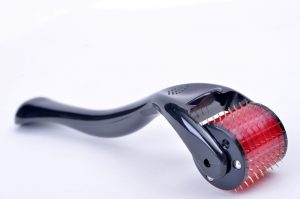 Due to the 1997 discovery, German doctors created the first model of what is now known as a dermal roller which contained anywhere up to 600 needles. However, the mechanical action of rollers resulted in an ‘arcing cut’ penetration, which results in unnecessary pain and tissue destruction.
Due to the 1997 discovery, German doctors created the first model of what is now known as a dermal roller which contained anywhere up to 600 needles. However, the mechanical action of rollers resulted in an ‘arcing cut’ penetration, which results in unnecessary pain and tissue destruction.- In 2010 the first Dermapen was created by an Australian Medical Developer and since then has become the main tool used for micro skin-needling surpassing the old outdated tools used prior to its invention.
